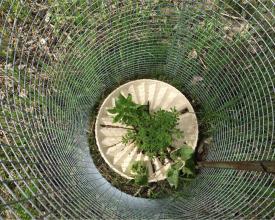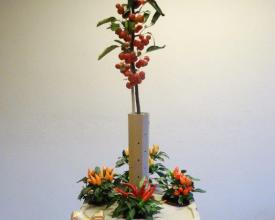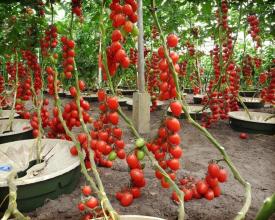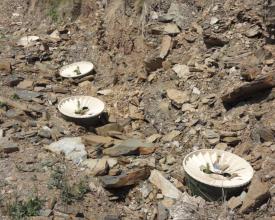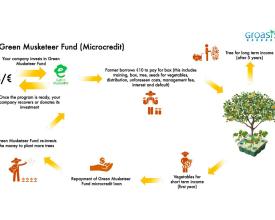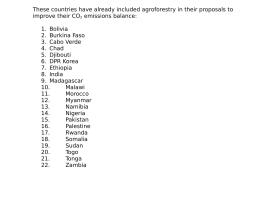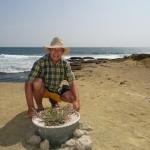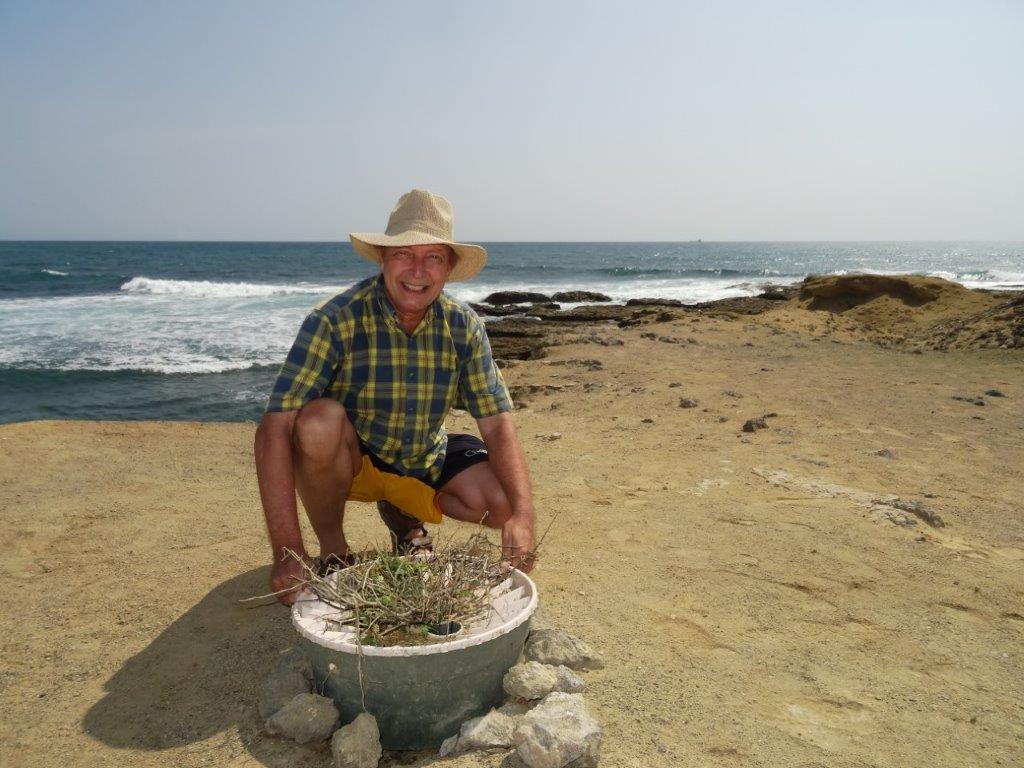
90% Water saving in agriculture with Growboxx® plant cocoon
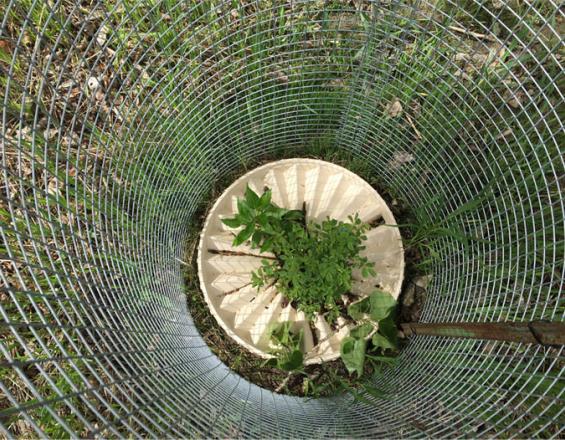
Groasis Ecological Water Saving Technology consists of 5 steps that can be taken together or each step individually. It works according to the 'Triple 90 benefits': 90% less water use, 90% cheaper and +90% survival rate. The steps are 1) Stimulating rainwater infiltration in the soil through making 15 kms of mini-terraces per hour with the Terracedixx / 2) Digging planting holes with the Capillary drill that keeps the soil capillary system intact / 3) Using Growmaxx mycorrhizae to help improve the function of or replace fertilizers / 4) Using the intelligent bucket Growboxx® plant cocoon and 5) Using the Growsafe plant protector against goats/ sheep. The technology allows to plant productive trees (orchards, timber, medicines, fodder) in combination with vegetables. They produce food and create short term revenues that allow to finance the technology through microcredit. The technology can be used by literate and illiterate, is gender neutral and does not require cultural adaptation.
Context
Challenges addressed
Water scarcity is an enormous challenge for humanity. Agriculture nowadays uses over 73% of all fresh water use. In Africa the figure is over 85%. The world populalation will rise from 7 to 9 billion within 35 years. In general wealth also rises, so food consumption will rise. It is expected that the food use will rise approxiamtely 40% within the next 35 years. For the production of food we need water, so water use for food production will rise with 40% also if our agricultural technologies will not change. The Groasis Ecological Water Saving Technology can help solve this challenge.
Location
Process
Summary of the process
The world has 2 billion hectares of dry, degraded, once fertile, nowadays eroded land. Until now it was not possible to plant this area, since one needs irrigation to plant it. Aside of the huge capital and energy needed for irrigation, the world also does not have enough water. The Groasis Ecological Water Saving Technology solves these problems. It is cheap, easy to use, doesn't need wells nor pumps nor an irrigation grid or an electricity grid. It is also easy to adapt by traditional agricultural societies. There is only one problem to solve: the potential 500 million poor rural families have no capital or financing instruments. The combined tree planting - vegetables planting capacity of the Growboxx® plant cocoon solves this problem. The buying of a Growboxx®, a tree, vegetables seeds, a plant protector and training can easily be paid with microfinance credit. The Green Musketeer Fund is now negotiating with partners to receive funds and deliver low cost (less than 1 USD/ton) CO2 credits for these funds. CO2 offset will help us to finance agroforestry and will help to make the soil fertile again by raising the humus content from 0.1% to 4% and through this its water and mineral holding capacity in the next century.
Building Blocks
Triple 90 water saving benefits in 5 building blocks
The Groasis Ecological Water Saving Technology consists of 5 building blocks:
1) Growboxx®/Waterboxx® plant cocoon
intelligent bucket
Provides water to a tree and vegetables while creating a healthy micro-climate. Both boxes use 90% less water and provide a survival rate of +90%.
2) (Bio)Growsafe Telescoprotexx
protects plants
Plant protector against heat, frost, wind, (sand)storms, and grazing animals. Protects plants and speeds up to plant growth. Available in carton or polypropylene.
3) Growmaxx Mycorrhizae
assists and/or replaces fertilizer
Fungi that feed the plant and support a healthy root system. Fertilizers contain salt and in dry soil often burn the roots. Mycorrhizae replace expensive fertilizers (natural alternative) while supporting faster plant.
4) Capillary Drill
elevates planting productivity
Machine used to accelerate making planting holes while leaving the capillary system intact. Digging planting holes by hand takes 15 min/hole (32 – 40 holes/day). Capillary drill makes 6.000 holes per day.
5) Terracedixx
increases water infiltration
Machine is used to make mini-terraces to stimulate increased rainwater infiltration into the soil. Currently just 25% of (rain)water enters the soil in degraded areas, by using the Terracedixx up to 90% is harvested.
Enabling factors
Each one of the 5 steps may be taken individually. One can only use the Growboxx® plant cocoon and leave the rest.
E.g. instead of Growsafe plant protector, use fencing.
Instead of the mycorrhizae use fertilizer.
Instead of the Capillary drill make the planting holes by hand.
Instead of using the Terracedixx built terraces by hand.
Lesson learned
Until now Groasis has sold its technology in 42 countries that are harrased by drought. Aside of all the technological inventions, three main subjects are very important:
1) Training. It turns out that users immediately adapt the technology. But it has to be explained at least one time.
2) The right species on the right place. One cannot plant an apple tree in the Kuwaiti desert, and not a mango tree in the Northern European countries. The chosen species has to be able to adapt to the climate.
3) The right variety of vegetables. It turns out that we find immense differences in productivity between varieties. E.g. under the same circumstances one tomato variety produces 20 kilos per Growboxx® and another variety produces 50 kilos per Growboxx®. It is important to test varieties before scaling up.
Microfinance for Growboxx® plant cocoon
Financing the plantation of trees in poor developing countries is impossible. Banks need collateral but in general there is common land ownership and no kadaster. Often the population register is not complete so banks do not know where the money lender lives. At last trees start to produce after 5 to 7 years and banks want the interest and redemption as of the first year, so the money lender cannot pay its loan. For this reason not enough productive trees are planted, although agroforestry would be the best solution for dry and eroded countries.
The planting of trees in combination with vegetables offers a possibility to microfinance the planting. The trees cause long term cashflow, the vegetables produce food for the family, and they can sell their overproduction which causes the short term cashflow. The short term cashflow enables them to pay their microfinance. The microfinance can be done with a revolving fund.
The vegetables production in combination with the efficient water use, offers a possibility to reforest the world with productive trees.
The microfinance can be given by a revolving fund. The money lender lends money, repays within a year, the fund can lend it again. This system can repeat itself eternally.
Enabling factors
At the moment we are working on a scheme where companies fund the revolving fund and receive carbon credits. Already 22 countries accept agroforestry as a way to offset CO2. We can offset CO2 for less than 1 USD costs per ton.
The interesting factor is that the offset CO2 through agroforestry, enriches the soil. Through photosynthesis the trees disconnect the CO2 in C and O2. The O2 retruns to the atmosphere. The C is used to produce food, medicines, fodder, timber, etc. Over 35% of the C is entering the soil in order to be transformed to humus.
Lesson learned
Trees as a CO₂ offset solution
COP21 Paris Treaty accepts carbon sinks through trees, as outlined in article 4.1 – page 21:
In order to achieve the long-term temperature goal set out in Article 2, Parties aim to reach global peaking of greenhouse gas emissions as soon as possible, recognizing that peaking will take longer for developing country Parties, and to undertake rapid reductions thereafter in accordance with best available science, so as to achieve a balance between anthropogenic emissions by sources and removals by sinks of greenhouse gases.
22 Countries have now accepted agroforestry as a CO₂ offset solution.At the moment we are having discussions with the first multinational company to use agroforestry as their CO2 offset program. This way we combine preventing climate change in a sustainable way in combination with necessary social components.
Impacts
Drought and poverty are friends. To break through this chain we need to create wealth in agricultural areas, since in most of these countries agriculture still forms 90% of the economy. Nowadays agriculture in dry areas is difficult because of the high water use and expensive investments to irrigate. Also, if done on a big scale, underground water tables deplete. 4 Countries have no groundwater anymore, in Mexico 24% of the wells is salted now. The UN expects 48 countries to suffer from severe water scarcity in 2025, while in the same time the world population grows to 9 billion in 2050. So we must find another way to grow and a more efficient way of the water we use for agriculture. With the Groasis Ecological Water Saving Technology we save 90% water in order to plant productive trees in combination with vegetables. Productive trees can grow in dry areas without irrigation.They have the capacity to grow with rain in peak periods and to overcome periods of drought. There are over 70 interesting species that can make the 2 billion hectares of available degraded land (source WRI) productive without irrigation. The low costs of the technology, mechanisation that helps rise the availability of water through rainwater infiltration in combination with the water saving, and the vegetables production, will help rise revenues, income and employment. In one word: create 'wealth'.
Beneficiaries
Rural families can plant productive trees in combination with vegetables. Vegetables can help the families giving food and revenues. The revenues can help financing through microcredit. The Groasis Technology does not require cultural adaptation.
Sustainable Development Goals
Story
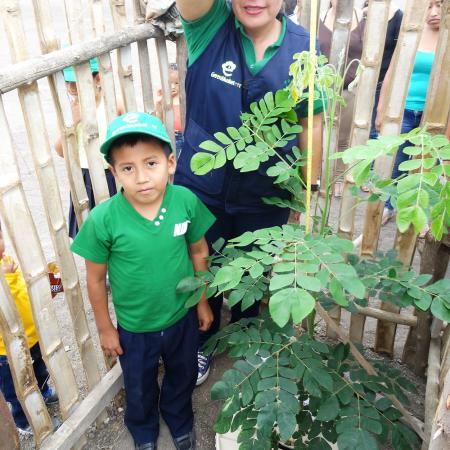
My background is that of a grower of vegetables, seed potatoes and flower bulbs. I used to travel all over the world to meet my clients and sell my products. When I was confronted with the water scarcity, the extreme poverty, the hunger, the situations without hope in eroded countries I felt ashamed as a human being and had a sort of anger and sadness.
This was what motivated me to make a big step. I made the choice to sell my international company in 2003, because I simply could not stand aside and look away from these terrible situations any longer.
Therefore I stood up and took the decision to use my knowledge as an international grower in the eroded countries. I cannot understand how we can accept that hundreds of millions of children are living without enough food, no healthy water, without education. Now I dedicate my life to help solve these problems in a positive way for a better future.

